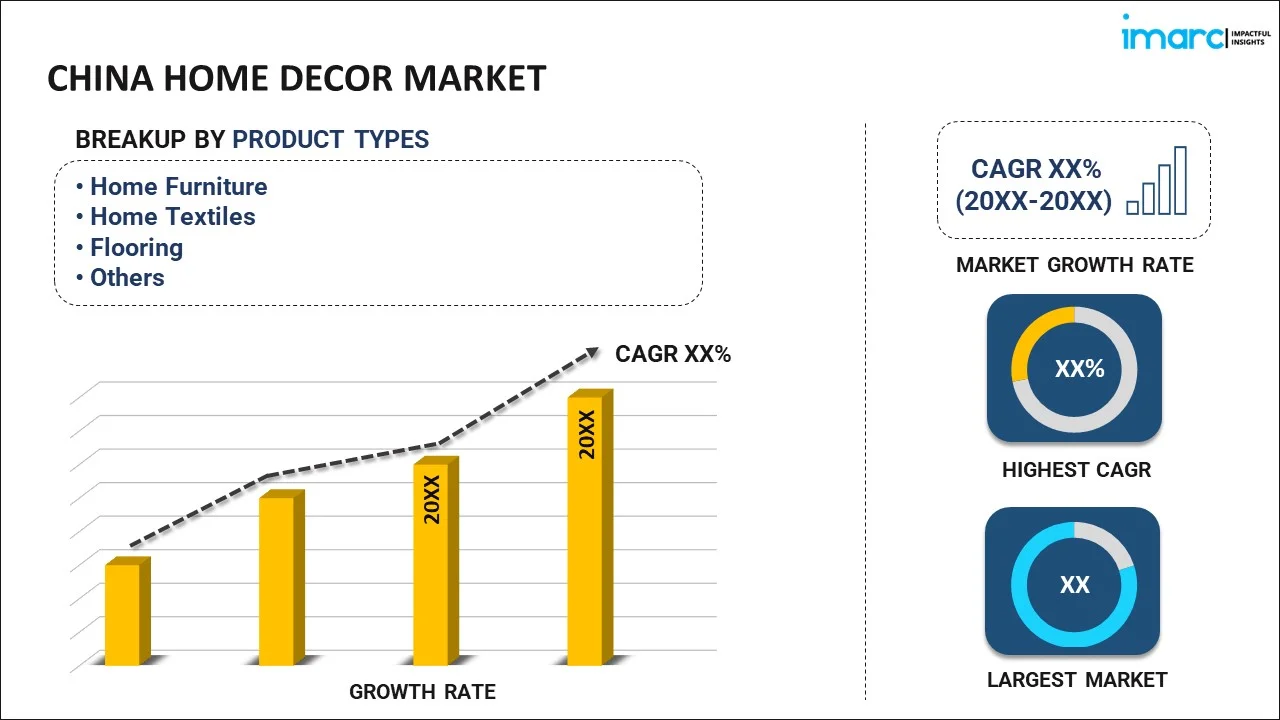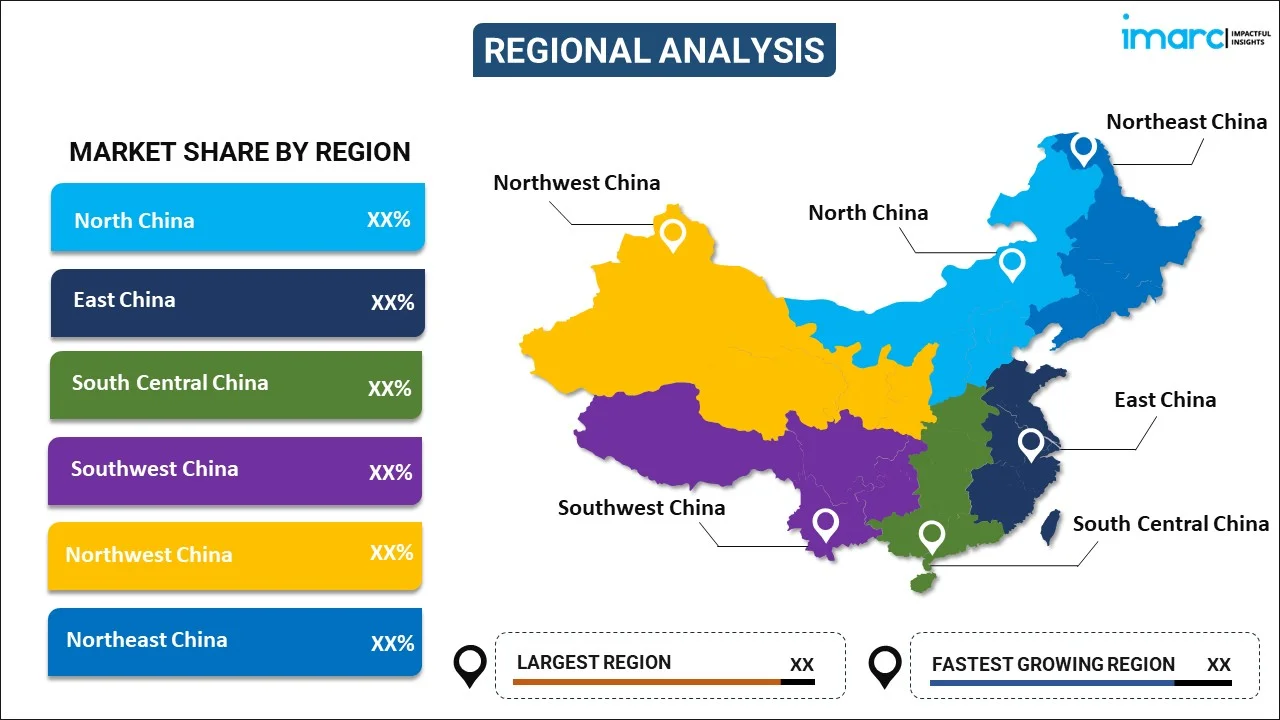
China Home Decor Market Report by Product Type (Home Furniture, Home Textiles, Flooring, Wall Decor, Lighting, and Others), Distribution Channel (Home Decor Stores, Supermarkets and Hypermarkets, Online Store, Gift Shops, and Others), and Region 2025-2033
China Home Decor Market Overview:
The China home decor market size reached USD 128.5 Billion in 2024. Looking forward, IMARC Group expects the market to reach USD 186.5 Billion by 2033, exhibiting a growth rate (CAGR) of 4.22% during 2025-2033. Rapid urbanization, rising disposable incomes, social media influence, rising eco-consciousness among individuals, smart home technology, experiential retail, expanding e-commerce, home renovation trends, cultural appreciation, and the escalating demand for stylish, sustainable, and innovative décor solutions are some of the factors providing a considerable thrust to the market growth.
|
Report Attribute
|
Key Statistics
|
|---|---|
|
Base Year
|
2024
|
|
Forecast Years
|
2025-2033
|
|
Historical Years
|
2019-2024
|
|
Market Size in 2024
|
USD 128.5 Billion |
|
Market Forecast in 2033
|
USD 186.5 Billion |
| Market Growth Rate 2025-2033 | 4.22% |
China Home Decor Market Trends:
Rapid Urbanization and Rising Disposable Incomes
In China, rapid urbanization, expanding cities, and the rise of new city construction have directly driven an increase in demand for industrial products including home décor. Recently, the just-released 14th Five-Year Plan (2021-25) has set a goal of 65% urbanization by 2025. The country began implementing them in 1953. Five-year plans are the government's blueprints for China's medium-term social and economic development. As more families move to cities, the demand for homes rises and each household seeks out a way to make their living space unique. At the same time, increasing spending on home improvement and decoration by China's growing middle class as a result of rising disposal incomes. The enhanced financial capability of this consumer segment has elevated their tendency to invest in premium and visually appealing home decor items which includes—furniture, decorative and accessories.
Influence of Social Media and Online Platforms
The power of social media and online platforms towards consumer behavior in the home decor market in China is one of the primary factors boosting the market growth. Social networking platforms like WeChat, Weibo and Xiaohongshu (Little Red Book) are an integral part of a trend setting discoverable platform. This is especially common of millennials and Gen Z consumers looking for influences from influencers or peers showing their home décor style. They are exposed digitally, which creates the demand for stylish and visually pleasing decor items to prop in their own social profile. The visual nature of these platforms, along with the direct linking to e-commerce sites make point-and-click purchasing a natural fit, benefiting spur-of-the-moment buying behavior. Moreover, the advent of live-streaming e-commerce (in which influencers promote products in real time) has also changed consumer interaction with home décor as well as the way they purchase such items.
Growing Awareness of Environmental Sustainability
Growing awareness of environmental sustainability among Chinese consumers has significantly influenced the home décor market. With increasing concerns about environmental degradation and climate change, there is a rising demand for eco-friendly and sustainable home décor products. Consumers are becoming more conscientious about the environmental impact of their purchases, favoring items made from recycled, natural, or sustainably sourced materials. This shift in consumer preference has prompted manufacturers and retailers to adopt green practices and offer products that align with these values. Sustainable home décor options, such as furniture made from reclaimed wood, energy-efficient lighting, and biodegradable home accessories, are gaining popularity. Additionally, brands that emphasize their commitment to sustainability through transparent sourcing and production processes are more likely to attract environmentally conscious consumers. This trend not only supports environmental conservation but also drives innovation in product design and manufacturing within the home décor industry.
China Home Decor Market News:
- In 2024: Ikea said it plans to invest RMB 6.3 billion ($864 million) in the Chinese market over the next three years to enhance and integrate its existing assets and carry out building work.
- In 2023: Shanghai-listed Xiamen C&D Inc. announced to purchase around 1.3 billion shares in Red Star’s holding company, representing 29.95 percent of the mall operator’s total issued share capital, at a consideration of up to RMB 6.3 billion ($938 million).
China Home Decor Market Segmentation:
IMARC Group provides an analysis of the key trends in each segment of the market, along with forecasts at the country level for 2025-2033. Our report has categorized the market based on product type and distribution channel.
Product Type Insights:

- Home Furniture
- Home Textiles
- Flooring
- Wall Decor
- Lighting
- Others
The report has provided a detailed breakup and analysis of the market based on the product type. This includes home furniture, home textiles, flooring, wall decor, lighting, and others.
Distribution Channel Insights:
- Home Decor Stores
- Supermarkets and Hypermarkets
- Online Store
- Gift Shops
- Others
The report has provided a detailed breakup and analysis of the market based on the distribution channel. This includes home decor stores, supermarkets and hypermarkets, online store, gift shops, and others.
Regional Insights:

- North China
- East China
- South Central China
- Southwest China
- Northwest China
- Northeast China
The report has also provided a comprehensive analysis of all the major regional markets, which include North China, East China, South Central China, Southwest China, Northwest China, and Northeast China.
Competitive Landscape:
The market research report has also provided a comprehensive analysis of the competitive landscape. Competitive analysis such as market structure, key player positioning, top winning strategies, competitive dashboard, and company evaluation quadrant has been covered in the report. Also, detailed profiles of all major companies have been provided.
China Home Decor Market Report Coverage:
| Report Features | Details |
|---|---|
| Base Year of the Analysis | 2024 |
| Historical Period | 2019-2024 |
| Forecast Period | 2025-2033 |
| Units | Billion USD |
| Scope of the Report | Exploration of Historical Trends and Market Outlook, Industry Catalysts and Challenges, Segment-Wise Historical and Future Market Assessment:
|
| Product Types Covered | Home Furniture, Home Textiles, Flooring, Wall Decor, Lighting, Others |
| Distribution Channels Covered | Home Decor Stores, Supermarkets and Hypermarkets, Online Store, Gift Shops, Others |
| Regions Covered | North China, East China, South Central China, Southwest China, Northwest China, Northeast China |
| Customization Scope | 10% Free Customization |
| Post-Sale Analyst Support | 10-12 Weeks |
| Delivery Format | PDF and Excel through Email (We can also provide the editable version of the report in PPT/Word format on special request) |
Key Questions Answered in This Report:
- How has the China home decor market performed so far and how will it perform in the coming years?
- What has been the impact of COVID-19 on the China home decor market?
- What is the breakup of the China home decor market on the basis of product type?
- What is the breakup of the China home decor market on the basis of distribution channel?
- What are the various stages in the value chain of the China home decor market?
- What are the key driving factors and challenges in the China home decor?
- What is the structure of the China home decor market and who are the key players?
- What is the degree of competition in the China home decor market?
Key Benefits for Stakeholders:
- IMARC’s industry report offers a comprehensive quantitative analysis of various market segments, historical and current market trends, market forecasts, and dynamics of the China home decor market from 2019-2033.
- The research report provides the latest information on the market drivers, challenges, and opportunities in the China home decor market.
- Porter's five forces analysis assist stakeholders in assessing the impact of new entrants, competitive rivalry, supplier power, buyer power, and the threat of substitution. It helps stakeholders to analyze the level of competition within the China home decor industry and its attractiveness.
- Competitive landscape allows stakeholders to understand their competitive environment and provides an insight into the current positions of key players in the market.
Need more help?
- Speak to our experienced analysts for insights on the current market scenarios.
- Include additional segments and countries to customize the report as per your requirement.
- Gain an unparalleled competitive advantage in your domain by understanding how to utilize the report and positively impacting your operations and revenue.
- For further assistance, please connect with our analysts.
 Request Customization
Request Customization
 Speak to an Analyst
Speak to an Analyst
 Request Brochure
Request Brochure
 Inquire Before Buying
Inquire Before Buying




.webp)




.webp)












